Bridge Technologies
Every year, the broadcast industry descends en masse on the RAI Convention Centre in Amsterdam. Once again, IBC provided invaluable insight into what’s going on — and where we’re going.
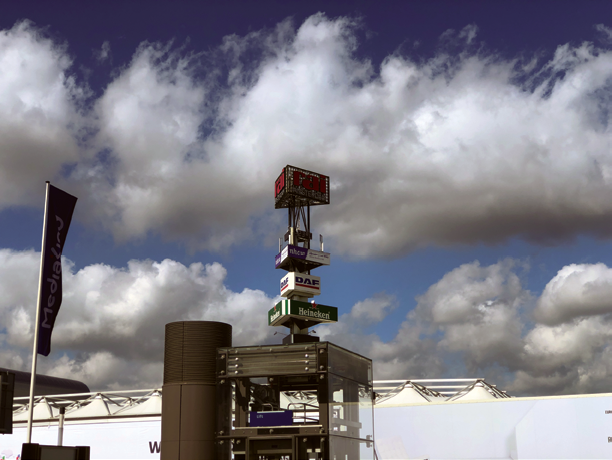
The RAI in Amsterdam.
One of the great things about the timing of IBC — in September — is the opportunity it provides to get a snapshot of the state of the industry towards the end of any given year —as well as a look forward to what we might see in the coming year and beyond.
IBC this year was particularly interesting, not least because several discussions with the foremost satellite companies revealed an interesting shift in how they see themselves. That shift was very much reflective — inevitably so — of the wider shift in the broadcast industry.
There was much discussion of “the customer journey” — the different points on the path towards wholly embracing IP that each organization is on, and the need for vendors to acknowledge that and provide situationally-appropriate solutions. Some organizations, for example, are still wedded to the on-premise paradigm while others have wholly embraced the cloud.
Wherever those organizations are, however, it was certainly clear that the age of monolithic data centers is long gone. IBC saw much talk, and not for the first time, of distributed intelligence and edge computing. That’s inevitable: media distribution has become all but mission critical and, as such, potential points of failure.
Hybrid
If “customer journey” was something you heard repeatedly in Amsterdam, another frequently used word was “hybrid”. Everyone, it seemed, was talking about hybrid solutions. And: that was certainly true of those satellite companies.
According to a senior manager at one of these firms, his company is building an ecosystem exactly in line with the challenges he sees his customers experiencing. They were, he said, looking for a converged approach to the problem of using the appropriate connectivity technology for many disparate requirements: no single connectivity technology could be the best for every environment.
As such, his company — in common, it must be said, with others — was in the process of reinventing itself: satellite would still be at its heart, but that would be only one of the connectivity solutions it would be able to offer. As with so many other exhibitors, satellite operators are looking to become full service providers, providing complete end-to-end solutions.
______________________________________
In theory, 5G also represents a
challenge to satellite companies,
although the consensus at IBC 2019
was that such was not the case.
It would have been easy, based on these conversations, to conclude that satellite, as a way of getting content from point A to point B, was diminishing in importance.
Nothing, of course, could be further from the truth: in many environments and for many applications, satellite remains the only show in town. Increasingly, however, it has become part of a communications ecosystem and satellite companies are seeing how they can be uniquely placed to play successfully in that world.
While IP is inexorably changing the broadcast world — for the better — satellite companies continue to face their own unique challenges. At IBC, we saw significant interest in our VB273 Intelligent Redundancy Switch.
Originally developed in response to a major operator’s request for a redundancy switching solution, it provides full dual path redundancy for satellite signals with autonomous operation and deep signal analysis on both signal paths for the ultimate in switching decision making. The solution is ideal for providing fast and robust redundancy switching for permanently installed satellite up-links or in outside broadcast systems.
Intelligence at the Edge
One of the characteristics of the VB273 for satellite companies is how — in line with what’s happening throughout the industry — it moves intelligence to the network edge, distributing decision-making way beyond the confines of the data center.
In automatic mode, the VB273 system is fully independent and makes its own switching decisions based on the pre-set switching rules. In manual mode, the unit can be controlled from any overlying NMS system via the extensive XML-based Eii (External Integration Interface) or via SNMP triggers.
Previously, it was the case that simple, relatively crude ETR alarm analyzers and black box switching solutions were deployed, but these were a much less than perfect response to broadcasters’ requirements: they were inflexible, and could even themselves cause problems and increase costs by generating ‘false positives’ or missing complex error conditions.
The Bridge VB273 system’s analysis capabilities and decision engine make it more comprehensive and accurate, giving greater security as well as delivering the cost reductions that can be achieved through running a more intelligent solution that can be trusted to operate with a greater degree of autonomy.
By incorporating a full implementation of Bridge Technologies’ advanced ETR290 analysis engine, the VB273 can use a greater range of criteria, and base decisions on a more nuanced and realistic assessment of the data. Error conditions are evaluated against a set of user-defined rules to determine the appropriate automated action in any operational scenario.
The ETR290 engine is an ETSI TR 101 290 alarm monitor and advanced analysis functionality feature for the series of devices. A device can be configured with up to eight individual ETR290 engines running in parallel on the Ethernet interface providing highly scalable monitoring and analysis.
Even More Sophisticated
Bridge Technologies has also developed Gold TS to provide capabilities that are even more sophisticated than those featured in the ETR290 engine.
Conditions such as failures of the conditional access system, errors in the program guide, and unintended language changes seriously affect subscribers — but standard monitoring systems based only on ETR290 do not raise an alert for these conditions.
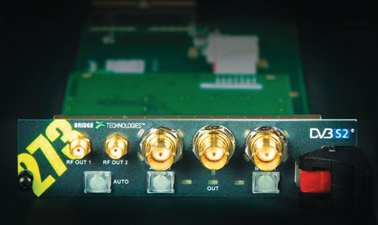
Services protected by Gold TS catch these ‘ETR290-legal’ errors and provide a much more valuable real-world quality assurance for operators of digital media services.
The VB273 also features a unique superlocal mode feature to deliberately cut off overlying NMS control for emergency manual override situations via the front button panel. All parameters can be controlled via the built-in web GUI. The web GUI also gives a visual overview of parameters used in switch decisions and system status.
Multiple layers of redundancy are also a feature of the VB273. The 1RU chassis offers dual redundant power supplies and the VB273 switching card has magnetically latching relays to protect against signal disruption, even during a complete loss of power.
In use, the VB273 Intelligent Satellite Redundancy Switch integrates readily into the Bridge Technologies monitoring ecosystem, providing exceptional advanced data analysis functions through rich graphical displays, with full reporting capabilities to external network management systems.
The data from the system is made available for remote monitoring by the built-in web server so that engineers and maintenance staff can be kept aware of operating status and can interrogate the system from any location.
Challenges
The VB273, then, is designed to address an important challenge for satellite operators — but, at IBC 2019, it became clear that it’s not the only challenge that they’re addressing and successfully overcoming.
Returning to the ‘hybrid’ theme, one particularly compelling live demonstration saw a new technology being demonstrated that synchronizes OTT and satellite broadcasts to provide a consistent experience for viewers — potentially eliminating a source of consumer frustration in which, for example, an OTT viewer hears a shout of “Goal!” from those in the apartment above him before the goal has actually appeared on his screen.
In theory, 5G also represents a challenge to satellite companies, although the consensus at IBC 2019 was that such was not the case: 5G will simply represent a complementary delivery mechanism to all the others, and will just form part of the connectivity mix.
IBC 2019 was, then, all about an industry in transition — and that applied equally to satellite operators. When will that transition end, such that we’ll reach a final state – the promised land?
The answer, of course, is: not any time soon. The rate of change in media creation, distribution and consumption is accelerating rather than slowing down — uniquely enabled by IP — and IBC 2020 promises to be no less fascinating in terms of the opportunity, once again, to gauge where we are and where we’re going.
bridgetech.tv

Simen K. Frostad is Chairman and co-founder of Bridge Technologies. Simen founded Bridge Technologies in 2004, after creating the world’s first IP/MPLS contribution network for Scandinavian sports coverage. Simen had previously built the first multi-camera hard disk recording system for episodic drama production in 1998, and the first nonlinear sports editing facility during the 1994 Winter Olympics.
CALIAN SED
Over the past year, the theme for Calian SED continues to be growth and innovation. The company is a global supplier of sophisticated satellite communication systems, products and services, and they have been serving customers for over 50 years.
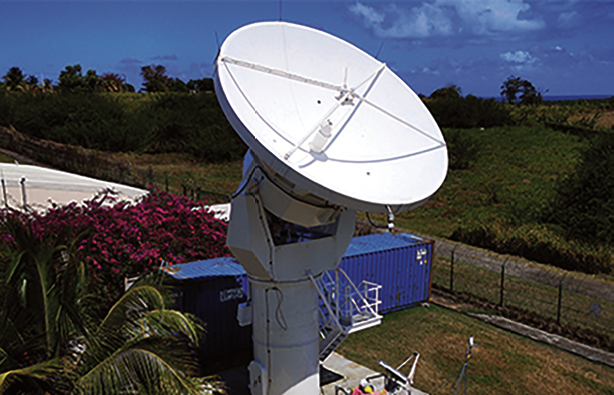
Calian SED’s business line includes communication ground systems and services, communication gateways and planning systems, as well as lines of communication products that are tailored to support customers in the satellite industry.
Calian SED offers a tightly integrated approach with the offered engineering design services and manufacturing capacity co-located in a single purpose-built facility. The company has the expertise, capacity and resources required to design, build and fully test each component of the deliverable ensuring performance in the most demanding environments.
Satellite advancements in capacity, functionality, speed and complexity are bringing significant opportunities, as well as, industry challenges including requirements for increased performance and flexibility of the ground system hardware and software. Calian SED, along with its partners, has been developing innovative new technologies to ensure these challenges are met. Recent contract wins are evidence of the company’s leading position in the delivery of complex satellite Earth station projects and programs.
Communication Ground Systems and Services
At Calian SED, the communication ground systems and services business unit provides RF ground systems for satellite tracking, communications and control.
___________________________________
Development is underway in
several new and exciting areas,
with product announcements
forthcoming next year.
The big announcement this year was Calian SED’s new line of composite carbon fiber reflector medium and large-aperture antenna systems with cutting edge performance for the most demanding satellite applications. This new composite carbon fiber reflector technology positions Calian SED for provision of the future higher frequency Q/V band RF systems. With growing bandwidth demand, satellite operators are looking to exploit the higher bands, with higher bandwidths and additional throughput to their network offerings. The company is uniquely positioned to provide the antenna systems required to meet these new demands.
Calian SED continued, this year, to supply numerous RF ground systems and equipment upgrades to customers, meeting the most demanding requirements, capabilities, and environments. With a focus on customer satisfaction and management of requirements, the ground communication systems group, provides solid turnkey RF gateway solutions for L-, S-, X-, C-, Ku-, Ka-band, as well as the higher frequency bands with challenging requirements such as Q- and V- bands.
Communication Gateways and Planning Systems
The company’s communication gateways and planning systems business unit provides software solutions for satellite communications, capacity management and performance monitoring. Over the past year, Calian SED has deployed a variety of satellite capacity and real-time management solutions around the world.
Satellites with flexible payloads have been driving interest for next generation capacity planning and payload management tools to leverage the satellite’s dynamic configurability that align with changing customer and network demands.
Calian SED has been addressing this need by providing innovative real-time satellite resource management and capacity planning software solutions that allows customers to efficiently plan and direct satellite capacity to meet their geographical demands and changing business needs.
Calian SED has invested in a large engineering staff with experience in systems engineering, software development, hardware development and embedded logic design.
With the growth of the company’s engineering pool over the past year, this experienced team has the agility and experience required to support the most complex needs of their customers and the satellite industry in general.
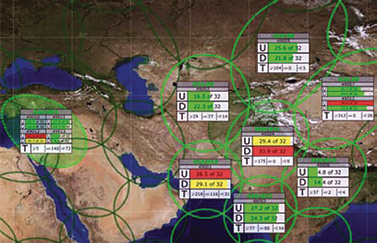 Calian SEDs’ SATCOM Gateways.
Calian SEDs’ SATCOM Gateways.
Communication Products
Calian SED’s line of satellite communication products continues to provide customers with innovative and high performance units that are used in their networks and integrated into their service offerings. These communication products also serve as the building blocks for the delivered systems, which offer a more compelling value proposition, providing cost-effective innovative technology, while also reducing risk and time to market.
In 2019, the company introduced the Decimator D4 Spectrum & Signal Analyzer, which is the fourth generation model of the firm’s flagship product line.
Decimator is popular for standalone operations in teleports and gateways, as well as for inclusion in satellite carrier monitoring systems from Calian SED and other vendors.
The Decimator D4 includes expanded capabilities as well as new features for spectrum and signal analysis. The Decimator D4 platform has ample processing power and substantial capacity for further enhancements — stay tuned in 2020 for additional Decimator product evolution.
While the existing modulator product line supports standard DVB-S/S2/S2X applications, the company specializes in developing custom and innovative products based on the latest technology and architectural concepts.
Calian SED’s multi-channel modulator and intelligent switching technologies offer an attractive and reliable way to reduce capital and operating expenses. In addition, this SDTS modulator continues to have a significant presence in the satellite precise positioning market.
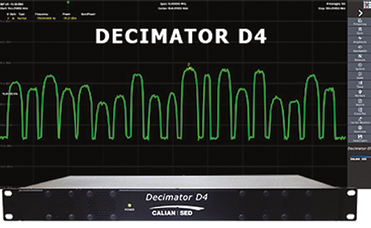
Development is underway in several new and exciting areas, with product announcements forthcoming next year.
Calian SED’s satellite test and monitoring systems continue to be popular in the marketplace. Mon-A-Co, the Monitor and Control Systems product, has proven to be comprehensive and reliable for satellite gateways.
Coupled with innovate uplink power control capability and the company’s carrier monitoring system, the M&C is a critical application for always-on Ka-band and higher frequency Q/V-band gateways and TT&C systems.
As part of the test systems product line, Calian SED has deployed multiple in-orbit test systems to test complex communication payloads after launch to validate operating characteristics.
2019 has been an exciting year for Calian SED. Together, with its partners, the company is looking forward to continued growth, challenges and opportunities in 2020.
www.sedsystems.ca
CPI Antenna Systems Division
During the past year, the Antenna Systems Division (ASD) of CPI has reached major milestones as the company moves further in building a diverse antenna portfolio with the quality brand that’s expected worldwide from CPI.
In the first full year of operation of the consolidated Antenna Systems Division, which includes the former Malibu Division, ASC Signal Division and recently acquired Orbital Systems and Quorum Communications, the combined talent has yielded enormous synergies from R&D collaboration as well as realizing significant operational benefits.
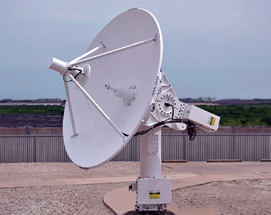
CPI ASD’s three-axis 5 meter S- and X-band antenna
system with a Cassegrain X-band feed and prime
focus S-band feed.
Melding two competing companies
into one consolidated team
is a complex mission —and it’s
extremely satisfying when the
parts come together.
Orbital Innovations
One of the major areas of focus in FY19 was the integration of Orbital Systems into ASD, following the August 2018 acquisition. Orbital Systems continues to be a leading supplier of full-motion TT&C (Telemetry, Tracking and Control) and EOS-DB reception antenna systems. In 2019, they expanded their technical capabilities by designing dual-band antennas using dichroic sub-reflectors that minimize the need for combiners, which in turn allows for best-in- class G/T performance.
Two new designs were completed and shipped; first a three-axis 5 meter S- and X-band antenna system with a Cassegrain X-band feed and prime focus S-band feed, and a second system design consisting of a 3 meter, three-axis, Ka-band antenna with integrated S-band. The latter antenna incorporates a Ka-band Cassegrain feed, with the S-band feed mounted at prime focus.
A frequency selective (dichroic) surface sub-reflector is used to split the bands between the feeds. Today, Orbital Systems is able to ship these new products with similar lead times to the legacy product designs, with typical delivery averaging four to five months.
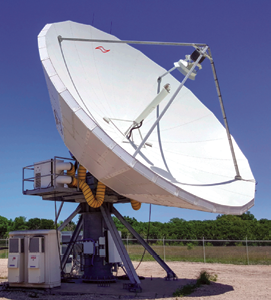
In addition, Orbital Systems has developed a new “RF over fiber” option that is integrated into these antenna systems. This capability provides superior performance in dynamic range, and adjustable matching of the range to the antenna, compared to aftermarket “RF over fiber” solutions.
Plus, Orbital Systems has shipped antenna positioners to radar systems developers for specialty radar applications in use today to help fight wild fires in California.
Internal Collaboration Continues to Pay Off
ASD has focused on technology and service enhancements. The company has advanced their development of products for high bandwidth SATCOM at Q- and V-bands by collaborating across the pools of expertise within their three operational facilities in Texas and California.
ASD’s advanced, multi-disciplined simulations have validated their technical approach toward an optimized system from IF to RF. As a testament to their efforts to exceed customers’ expectation on project execution, this year they have deployed two, turn-key, Ka-band large-aperture gateway systems in record times.
The company’s mobile solutions have become the products of choice for many demanding applications. Sophisticated features such as ARSTRAT compliance and low PIM operation have distinguished their 2.5, 4.0, and 4.6 meter products.
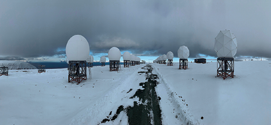
The company’s manufacturing facility in Whitby, Canada, is now able to produce antenna up to 13 meters in diameter.
Whitby operations has made significant strides towards streamlining their manufacturing operations and have now demonstrated their capability to produce large quantities of LEO/ MEO antennas, having shipped more than 100 during 2019 for a leading LEO constellation.
Some of these antennas have been in active service for TT&C since February 2019. ASD believes that the experience gained from such a large undertaking will serve them well on future pursuits of a similar nature.
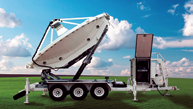
CPI ASD’s Trifold trailer-
mounted antenna.
Popular Trifold System Update
The ASD Trifold trailer-mounted antenna continues to set the standard for versatility and reliability and has been widely adopted by commercial and military end customers.
The company has commenced Trifold deliveries to satisfy commitments made as a result of a significant award from an existing customer on a major program of record, with expected duration of 10 years.
ASD has had a long history of using composite materials in the firm’s antenna solutions and expects the market demand for composite materials to increase due to their unique thermal and mechanical properties.
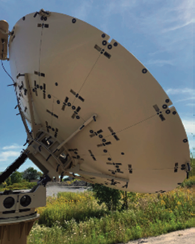
CPI has been incorporating proprietary techniques in the composite material reflectors to meet certain required specifications, such as the stringent low PIM (passive intermodulation) performance requirements for ARSTRAT. These sophisticated features that facilitate ARSTRAT compliance and low PIM operation have distinguished ASD’s 2.5 to 4.0 meter products from competing systems.
ASD’s Camarillo, California (Malibu), operations has followed a similar strategy in 2019 as they did in 2018; build upon the existing customer base by focusing on the core technologies for ground and airborne Line of Sight (LOS) data terminals.
The Camarillo operations have won several major programs this year, including solutions for the coveted MQ-25 program with Cubic, which will introduce a new variant of their AT-2 airborne terminal with a short-can configuration, plus the Sentinel program with Raytheon, which will incorporate their custom- designed high precision Radar pedestal.
ASD continues to manufactures the complete line of the former Andrew/GRANGER brand HF antennas operating in the 2 to 30 MHz frequency range.
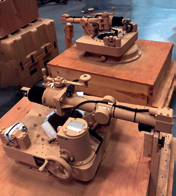
CPI ASD is one of a few remaining suppliers of such antenna systems in the world and continues to supply these systems to NATO and several foreign governments.
Additionally, the company received a major order for their L-band ATC (Air Traffic Control) Radar antennas, with additional orders expected in 2020.
Continuing to Strengthen the CPI Brand
On August 5, 2019, CPI announced that the company had entered into an agreement to purchase SATCOM Technologies, the antenna systems business of General Dynamics Mission Systems, a business unit of General Dynamics.
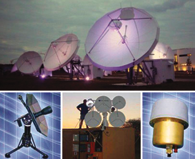
SATCOM Technologies designs, manufactures and installs satellite communications antenna systems used in commercial, defense and scientific applications.
This business will complement CPI’s existing portfolio of communications products for government, military and commercial applications and enables them to provide their customers with a wide range of complementary products, capabilities and resources to support this dynamic and growing market, making it an excellent fit for CPI.
www.cpii.com/division.cfm/14
Author Tony Russell is the President of CPI Antenna Systems Division and possesses 36 years of experience in the RF industry, primarily serving airborne and maritime radar, ground and airborne communications, and millimeter-wave science segments.

Mr. Russell has been with Communications & Power Industries (and its predecessor) for more than 25 years, serving in technical and management roles in CPI’s electron device solid-state HPA and antenna businesses. Currently, he serves as the president of the CPI Antenna Systems Division. Mr. Russell has an Honors degree in Physics from the University of York (UK) and an MBA from York University (Canada).
ETL Systems
2019 has been one of the most exciting years for ETL Systems. Kicking off the year with the acquisition of Atlantic Microwave in January, launching key new products, attending more global shows than ever before, ending with a royal visit at our headquarters in the heart of rural Herefordshire, UK.
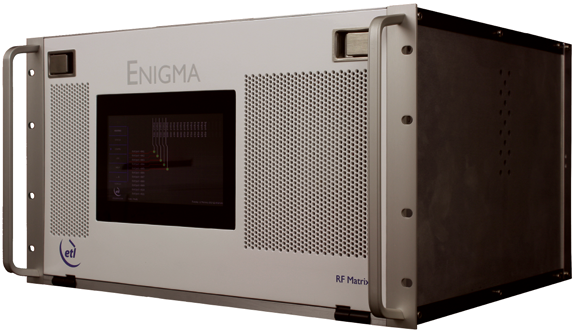
The Enigma l-band 32x32 Switch Matrix.
Moving into New Markets
The year started with us acquiring Atlantic Microwave, a leading provider of RF and microwave components and satellite communication test equipment. Atlantic Microwave is well suited to ETL; offering a wide range of complementary RF products but providing to a different customer base, enabling us to grow and find new opportunities together.
The strategic acquisition of Atlantic has meant growing our RF product range and presence to diversify into new markets such as SATCOM testing. Testing is obviously important to our customers and Atlantic’s high-quality products are providing another avenue of resilience
for ETL.
This year we have co-exhibited at several international trade shows, including NAB and 3CDSE, with our cooperative relationship going from strength-to-strength, we have further collaboration planned for 2020.
__________________________________________________
As the satellite industry continues to
evolve and with such a vast number of new
launches planned for the coming years,
we are continuing to develop our products
to meet those ever-changing needs.
New 4th Generation Enigma RF Matrix
In March, we launched six new upgraded models of our flagship Enigma L-band 32x32 Switch Matrix, for downlink and uplink signal management.
There are already more than 1,000 of our Enigma Switch Matrices in operation worldwide, with new features added to our most popular matrix including variable gain, improved noise figure and increased power savings. Variable gain on each output as a standard feature allows greater control of each signal level.
Unused routes on the splitter cards are unpowered to help save power. As with previous models, the latest generation has hot-swap, dual redundant CPU, PSU, and hot-swap single RF cards for enhanced resilience and minimal downtime.
The Enigma is a versatile Switch Matrix that can be used across a range of applications, including satellite communications, broadcasting, military, and government communication systems.
 The Hawk 1U L-band RF matrix.
The Hawk 1U L-band RF matrix.
Expanding the RF Components Sales Team
In response to growing demand for our RF components, we appointed Bethan Sant as our newest Components Sales Executive. Since the team expansion, we’ve won multiple large projects in Poland and Latin America for Waveguide RF components and amplifiers with RS485 controlled communications protocol.
The addition of an extra component’s sales executive has meant increased support for our global customers, with Bethan heading up sales for West and East Europe, Scandinavia, Russia, Africa, and Latin America, helping us to grow further across these regions.
Focusing on other projects of note, we also provided a sizeable system upgrade for an Eastern European Government, which included adding a second Vulcan Matrix, plus StingRay RF Over Fiber and Piranha LNB power supplies.
Another project success, in conjunction with a European integrator, included providing fiber links and an expandable 128 x 128 switch matrix for an automatically controlled teleport in the Middle East.
Attending Global Exhibitions
At ConnecTechAsia, a key show for our Asian customer base, the debut of our latest products occurred, including the new Enigma Switch and Harrier Switch Matrix.
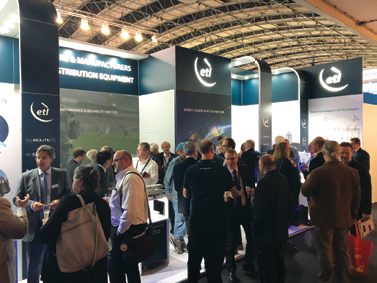 The ETL Systems booth at IBC2019.
The ETL Systems booth at IBC2019.
We also co-exhibited with Atlantic Microwave at the Three Counties Defence and Security Expo (3CDSE). As well as demonstrating our 64 x 64 Hurricane L-band matrix, which is used to provide flexibility in the routing of antennas to receivers or modems, and our StingRay RF
over Fiber range, which provides fiber links for short, medium and long distances.
We also showcased a range of Atlantic Microwave products and components. This included a miniature synthesizer, which enables customers to test satellite performance without having to send live signals over the network, as well as the company’s range of test cables and coaxial cable assemblies.
Launching New Technologies in RF Distribution
LEO launches are coming and will accelerate at an astounding speed, but no-one is really talking about the ground segment infrastructure that will be needed to support these launches. We have spent a great deal of time looking into this to ensure we are ready to support those launches.
Among numerous product launches during the year, our key product launches were at IBC this year. We launched a new compact 1U L-band RF matrix, Hawk.
As well as being suited for High Throughput Satellite (HTS) gateways and deployable VSAT terminals, the Hawk is designed for RF signal routing in Low Earth Orbit ground stations, which will require compact designs with high resiliency and flexibility.
The Hawk Matrix has capacity for two 8x8 matrix cards – which can be combining (fan-in) or distributive (fan-out) – for uplink and
downlink applications.
We also launched our Falcon KU to L-band block down frequency converter at IBC. It is a completely new rack system product which is a major step forward in high density redundant frequency converter designs. This will be an important focus for us in 2020 offering more frequencies for conversion of uplink and downlink.
ETL Systems Receives a Royal Visit
ETL was honored with a visit from HRH The Prince Of Wales due to the huge success the company has afforded globally, while working from a rural location.
HRH Prince Charles commented “It is wonderful to see such skilled engineering being applied in this particular field. Clearly you are producing very high quality, high standard equipment which is used to great effect by customers in over 180 countries. Ladies and gentlemen, I hope you go from strength to strength.”
HRH The Prince of Wales was given a tour of our facilities, met the staff working at our Herefordshire HQ and presented us with a commemorative plaque. We are extremely proud of our rural heritage, developing cutting-edge technology amongst the apple orchards of Herefordshire, so it was a great honor for that to be recognized by such an important visitor.
Growth and Innovation: Plans for 2020
As the satellite industry continues to evolve and with such a vast number of new launches planned for the coming years, we are continuing to develop our products to meet those ever-changing needs.

ETL continues to grow and we have extensive growth plans in place for 2020 including the launch of more frequency converters, development of some exciting new technology and attending more new global trade shows.
We look forward to an exciting year ahead.
www.etlsystems.com
The author is Andrew Bond, the Sales and Marketing Director for ETL Systems.

